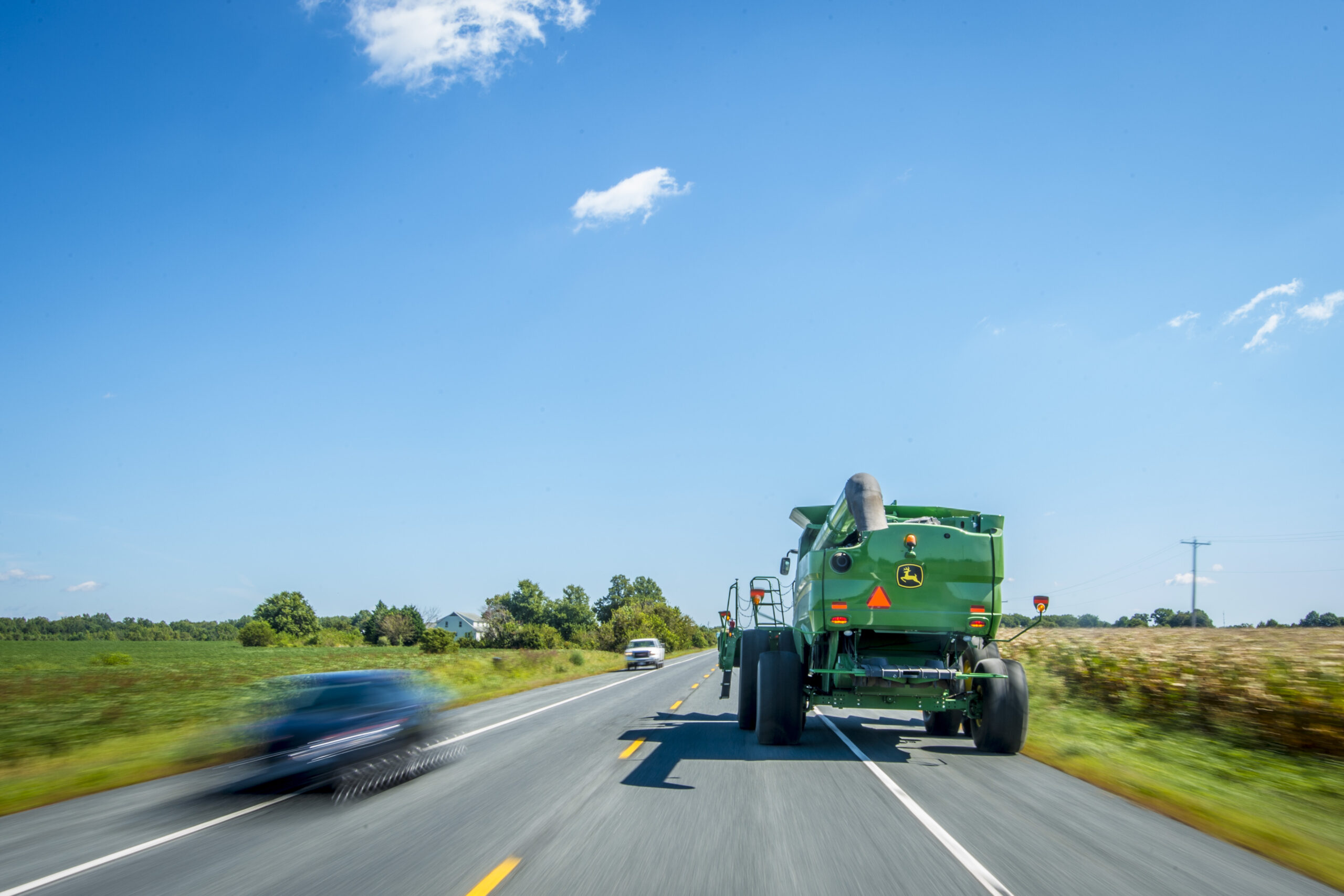Using a high-efficiency wood or pellet stove can be a cost-effective way to reduce your home heating costs compared to other fuels like natural gas, fuel oil, or electricity. According to Penn State Extension, the greatest savings are realized when you cut your own firewood rather than opting to buy pellets or have cordwood delivered. However, there are several hazards associated with use of a chainsaw or ax for felling trees or splitting firewood; the CDC estimates 36,000 people visit hospital emergency departments annually for injuries caused by chainsaws. If you plan to cut your own firewood this winter, it’s important to keep safety top of mind. [Read more…]
Stay Safe on the Road During the Harvest
Autumn is harvest season on the farm, and farmers are rushing to get the harvest in before the weather becomes cold. With harvest season getting underway, more heavy farm equipment is going to be out on the same roads as vehicle traffic, going from field to field, dramatically increasing the odds for accidents. During this season, it is important to be aware of the increased possibility of accidents and injury, especially when using farm machinery. One area to pay particular attention to is road safety while moving equipment. Here are some tips to help make sure the season is safe.

USDA Photo by Preston Keres
Make sure your farm vehicles and equipment are visible.
- Verify that all lights and flashers on your farm vehicle are working properly.
- Use warning flashers, flags, lights and slow-moving vehicle emblems on all equipment.
- Apply reflective tape to machines to improve visibility for motorists at dusk.
- Avoid traveling before dawn and after dusk if you can. If you need to drive during these times, ensure that your headlights are working. Headlights help you see and be seen.
- Consider the use of an escort vehicle following with lights and flashers
Also, make sure you know the size of all tractors, vehicles and equipment. Be mindful of the height of your farm equipment and avoid power lines, low bridges and other overhead obstacles. Remember to communicate with fellow motorists on the road. Use turn signals and hand signals whenever possible to communicate with fellow drivers. Avoid distractions and make safety a priority on the road. Also, particularly important is to pay attention to when you are feeling tired and fatigued. Taking a break to rest is an important safety tool not to be overlooked.
This post was written by Bill Bamka, County Agricultural Agent with RCE-Burlington County.
Be Proactive, Keep Youth Safe on the Farm
How often do you say this: “do as I say, not as I do”?
The farm can be a fun, engaging, and nostalgic place to raise children; however, life on the farm comes with inherent risks that require certain precautions to make the farm a safe place for kids. The curious nature of children makes this especially difficult, as they often exhibit a lack of fear or a clear understanding of danger. According to the Children’s Safety Network, 42% of fatal injuries to youth on U.S. farms involve machinery and motor vehicles (e.g. tractors, ATVs, etc.) while another 16% of fatal injuries are due to drowning. As the school year comes to a close and your own children and grandchildren spend more time on the farm, use your actions and attitude to establish safety as a priority.
In addition to being a positive role model, make time to identify hazards around the farm and implement changes to improve safety. We have included some of these hazardous “hot spots” in the table below, along with recommendations for injury prevention.
| Hazards for Children | Recommendations to Prevent Injury |
| Workshops, chemical and grain storage areas | Install gates, doors, or other locking systems to keep children out
Explain the meaning of warning signs around the farm Clean and dispose of empty chemical containers Establish designated safe play areas |
| Machinery and equipment | Equipment should be turned off, disengaged, and inaccessible
Leave front end loaders and similar equipment in the down position Lock vehicle cabs after use Keep vehicle keys out of reach of children Never allow children to play around machinery Never allow children (or anyone) to be an extra rider on a tractor |
| Livestock Pens | Only allow children to work with livestock under adult supervision
Secure livestock pens so children cannot wander into the area |
If you’re looking for fun ways to talk with children about farm safety, check out this farm safety activity book created by the National Child Safety Council. The book includes games, puzzles, crafts, and more on a wide array of topics from livestock and tractor safety to first aid.
For more details on age-specific hazards, protective measures, and appropriate tasks for youth check out our NJAES factsheet titled “Farm Safety Tips for Children”.
Source: Brennan, M.F. and Brumfield, R.B. “FS937: Farm Safety Tips for Children.” Rutgers University, March 1999. https://njaes.rutgers.edu/pubs/publication.php?pid=FS937. Accessed on 10 June 2021.
Stand Up 4 Grain Safety Week: March 29 – April 2
Every year hundreds of employees are injured or die from preventable hazards while working in grain storage and handling. Stand Up 4 Grain Safety Week, sponsored by the OSHA Alliance Program, is a coordinated industry effort to raise awareness of grain handling hazards and educate industry members to prevent injuries and incidents associated with grain handling.
Stand Up 4 Grain Safety Week 2021 will feature daily educational events which are virtual and free to attend. Be aware that the events begin at 10am CDT (11am EST).
- Monday, 3/29 – Kick-Off Event

- Tuesday, 3/30 – Near Miss Reporting
- Wednesday, 4/1 – Impact of Quality on Safety
- Thursday, 4/2 – Bin Safety
- Friday, 4/3 – Emergency Action Plans
Assert your commitment to grain safety by registering for these educational events via the Grain Handling Safety Coalition EventBrite page. For additional information and resources on grain safety, visit the Stand Up 4 Safety Week website at https://standup4grainsafety.org.
The OSHA Alliance Program includes the Great Plains Chapter of the Grain Elevator and Processing Society (GEAPS), the National Grain and Feed Association (NGFA), and the Grain Handling Safety Council (GHSC).
Cultivating a Farm State of Mind About Mental Health
American Farm Bureau Federation’s 2021 Ag Safety Awareness Program (ASAP) Week, which is taking place from February 28 to March 6, was created to bring awareness to safety and health issues facing the agriculture industry.
For farmers and ranchers, stress is a way of life. They depend on many factors that are out of their control, like weather, commodity prices, availability of labor, trade markets and a lot more. With the impacts of the COVID-19 pandemic, their stress levels have gone even higher and in many cases are reaching the breaking point.
A new survey from the American Farm Bureau found that more than half of rural adults and farmers/farmworkers say they are personally experiencing more mental health challenges than they were a year ago. Two in three farmers/farmworkers say the COVID-19 pandemic has impacted their mental health, and two in three have experienced feeling nervous, anxious or on edge during the pandemic. The percentage of farmers/farmworkers who say social isolation impacts farmers’ mental health increased 22% since April 2019, a significant finding given the long hours many farmers work alone.
This should be a wake-up call for everyone in the agriculture community, and we should all be doing our part to help.
As part of Agricultural Safety Awareness Week (Feb. 28 – March 6), Farm Bureau encourages everyone to learn to recognize the warning signs of chronic stress, engage in conversations and lend a helping hand.
When loved ones, neighbors or others we care about are experiencing mental health challenges, they may not even realize it, so it’s important to look for signs that they may be at risk. These include things like changes in routines or social activities, decline in appearance of
the farm or the care of domestic animals, increase in farm accidents, increase in illnesses or other chronic conditions, or decreased interest in activities or events.
If you see any of these signs, it’s time to show you care. It may feel like it’s out of your comfort zone, but there are simple ways to start a conversation. Remind them of something they’ve said about what’s concerning them, and express interest. Acknowledge what they’re going through. Share a habit you’ve seen change. And if you’re concerned, don’t wait for them to ask for help. Offer to help connect them to the many resources that are available for support. What matters most is showing genuine care and empathy, and listening.
It’s time we all took a stand to help those around us who may be experiencing the effects of chronic stress. Visit the Farm State of Mind website for more information about the warning signs of stress, tips for helping someone in emotional pain, ways to start a conversation, crisis hotlines, treatment locators and additional resources for managing stress, anxiety or depression. If we all do our part to help, we can strengthen our rural and farming communities and shine a ray of hope on those we care about.
‘Driving Safety Home’ is Theme of Agricultural Safety Awareness Program Week, Feb. 28 – March 6
Sharing resources that will help farmers and ranchers keep safety top of mind through the Agricultural Safety Awareness Program (ASAP) is a priority of county and state Farm Bureau leaders across the nation. As part of ASAP, Feb. 28 – March 6 has been designated as Agricultural Safety Awareness Week. U.S. Agricultural Safety and Health Centers will join Farm Bureau in promoting the week with its theme “Driving Safety Home.”
A different safety focus will be highlighted by Farm Bureau and U.S. Ag Centers each day of the week:
- Monday, March 1 – Farmer Roadway Safety
- Tuesday, March 2 – Caretaker Support
- Wednesday, March 3 – General Farmer Wellness
- Thursday, March 4 – Mental Health
- Friday, March 5 – Community Roadway Safety
During this week and throughout the year, Farm Bureau encourages farmers to make safety a priority on the farm.
The Agricultural Safety Awareness Program is a part of the Farm Bureau Health and Safety Network of professionals who share an interest in identifying and decreasing safety and health risks. For more information and resources, visit the ASAP Facebook page.
Visit the Centers’ YouTube channel (www.youtube.com/user/USagCenters) for new content and fresh ideas about how to stay safe while working in agriculture, forestry and fishing. Join the movement to keep farms safe and share your own safety messages on social media using the hashtags #KeepFarmsSafe, #ASAP21 and #USAgCenters.
The 11 U.S. Agricultural Safety and Health Centers (www.cdc.gov/niosh/oep/agctrhom.html) are funded by the National Institute for Occupational Safety and Health.
